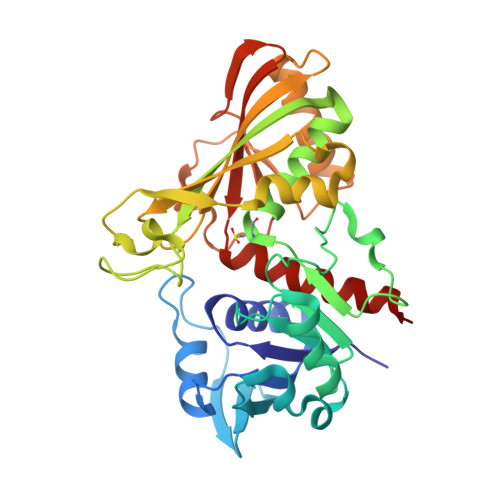Structural analyses to identify selective inhibitors of glyceraldehyde 3-phosphate dehydrogenase-S, a sperm-specific glycolytic enzyme.
Danshina, P.V., Qu, W., Temple, B.R., Rojas, R.J., Miley, M.J., Machius, M., Betts, L., O'Brien, D.A.(2016) Mol Hum Reprod 22: 410-426
- PubMed: 26921398
- DOI: https://doi.org/10.1093/molehr/gaw016
- Primary Citation of Related Structures:
5C7I, 5C7L, 5C7O - PubMed Abstract:
Detailed structural comparisons of sperm-specific glyceraldehyde 3-phosphate dehydrogenase, spermatogenic (GAPDHS) and the somatic glyceraldehyde 3-phosphate dehydrogenase (GAPDH) isozyme should facilitate the identification of selective GAPDHS inhibitors for contraceptive development. This study identified a small-molecule GAPDHS inhibitor with micromolar potency and >10-fold selectivity that exerts the expected inhibitory effects on sperm glycolysis and motility. Glycolytic ATP production is required for sperm motility and male fertility in many mammalian species. Selective inhibition of GAPDHS, one of the glycolytic isozymes with restricted expression during spermatogenesis, is a potential strategy for the development of a non-hormonal contraceptive that directly blocks sperm function. Homology modeling and x-ray crystallography were used to identify structural features that are conserved in GAPDHS orthologs in mouse and human sperm, but distinct from the GAPDH orthologs present in somatic tissues. We identified three binding pockets surrounding the substrate and cofactor in these isozymes and conducted a virtual screen to identify small-molecule compounds predicted to bind more tightly to GAPDHS than to GAPDH. Following the production of recombinant human and mouse GAPDHS, candidate compounds were tested in dose-response enzyme assays to identify inhibitors that blocked the activity of GAPDHS more effectively than GAPDH. The effects of a selective inhibitor on the motility of mouse and human sperm were monitored by computer-assisted sperm analysis, and sperm lactate production was measured to assess inhibition of glycolysis in the target cell. Our studies produced the first apoenzyme crystal structures for human and mouse GAPDHS and a 1.73 Å crystal structure for NAD(+)-bound human GAPDHS, facilitating the identification of unique structural features of this sperm isozyme. In dose-response assays T0501_7749 inhibited human GAPDHS with an IC50 of 1.2 μM compared with an IC50 of 38.5 μM for the somatic isozyme. This compound caused significant reductions in mouse sperm lactate production (P= 0.017 for 100 μM T0501_7749 versus control) and in the percentage of motile mouse and human sperm (P values from <0.05 to <0.0001, depending on incubation conditions). The chemical properties of T0501_7749, including limited solubility and nonspecific protein binding, are not optimal for drug development. This study provides proof-of-principle evidence that GAPDHS can be selectively inhibited, causing significant reductions in sperm glycolysis and motility. These results highlight the utility of structure-based drug design and support further exploration of GAPDHS, and perhaps other sperm-specific isozymes in the glycolytic pathway, as contraceptive targets. None. Coordinates and data files for three GAPDHS crystal structures were deposited in the RCSB Protein Data Bank (http://www.rcsb.org). This work was supported by grants from the National Institutes of Health (NIH), USA, including U01 HD060481 and cooperative agreement U54 HD35041 as part of the Specialized Cooperative Centers Program in Reproduction and Infertility Research from the Eunice Kennedy Shriver National Institute of Child Health and Human Development, and TW/HD00627 from the NIH Fogarty International Center. Additional support was provided by subproject CIG-05-109 from CICCR, a program of CONRAD, Eastern Virginia Medical School, USA. There are no conflicts of interest.
Organizational Affiliation:
Department of Cell Biology and Physiology, University of North Carolina School of Medicine, Chapel Hill, NC 27599, USA.

















